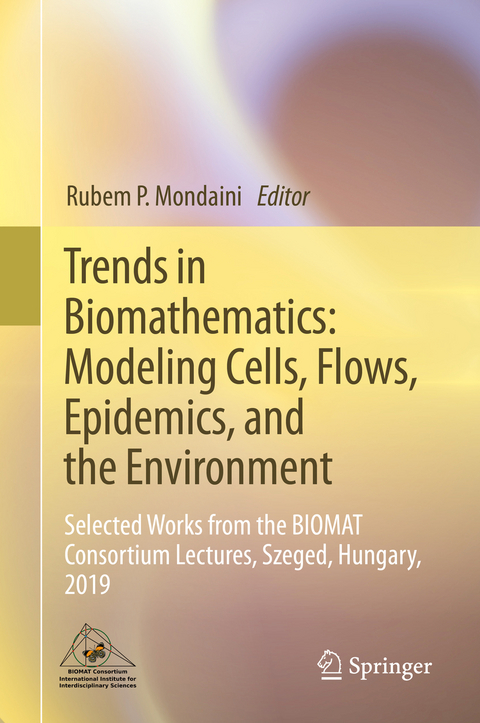
Trends in Biomathematics: Modeling Cells, Flows, Epidemics, and the Environment
Springer International Publishing (Verlag)
978-3-030-46305-2 (ISBN)
Held every year since 2001, the BIOMAT International Symposium gathers together, in a single conference, researchers from Mathematics, Physics, Biology, and affine fields to promote the interdisciplinary exchange of results, ideas and techniques, promotingtruly international cooperation for problem discussion. The 2019 edition of BIOMAT International Symposium received contributions by authors from 14 countries: Brazil, Cameroon, Canada, Colombia, Czech Republic, Finland, Hungary, India, Italy, Russia, Senegal, Serbia, United Kingdom and the USA. Selected papers presented at the 2017 and 2018 editions of this Symposium were also published by Springer, in the volumes "Trends in Biomathematics: Modeling, Optimization and Computational Problems" (978-3-319-91091-8) and "Trends in Biomathematics: Mathematical Modeling for Health, Harvesting, and Population Dynamics" (978-3-030-23432-4).
Rubem P. Mondaini is President of the BIOMAT Consortium/International Institute for Interdisciplinary Sciences and a Full Professor of Mathematical Biology and Biological Physics at the Federal University of Rio de Janeiro, Brazil. He holds a PhD in Theoretical Physics from the Brazilian Centre for Physical Research, Brazil. His research activities abroad include a period as a Visiting Scientist at the International Centre for Theoretical Physics (ICTP), Trieste, Italy (1978) and as a Senior Postdoc at the Department of Mathematics of King's College, University of London, UK (1986). He was also a Visiting Professor at the Centre of Physics of Condensed Matter, Lisbon, Portugal (1986) and at the Department of Chemical Engineering of Princeton University (2008). He has been the Chairman of the Annual BIOMAT Conferences since their inception during the BIOMAT 2001 Symposium in Rio de Janeiro, Brazil.
Evolutionary adaptation of the permanent.- A more realistic formulation of herd behavior for interacting populations.- On network similarities and their applications.- impacts of infections and predation on dynamics of sexually reproducing populations.- Global analysis of a cancer model with drug resistance due to microvesicle transfer.- Contact vaccination study using edge based compartmental model (ebcm) and stochastic simulation an application to oral poliovirus vaccine (OPV).- The Effect of Inhibitory Neurons on a Class of Neural Networks.- Pipette Hunter 3D: Fluorescent Micropipette Detection.- Delay Linear Chains in Mathematical Biology: Migratory Birds, Stem Cell Maturation, and Intracellular Chlamydia Infection.- Normalization of a periodic delay in a delay differential equation.- Competition between two tufted C4 grasses: a mathematical model.- Mathematical description of systemic and microcirculations.- The statistical analysis of protein domain family distributions via jaccard entropy measures.- Theoretical and numerical considerations of the assumptions behind triple closures in epidemic models on networks.- Recognition of protein interaction regions through time-frequency analysis.- Using a stochastic sir model to design optimal vaccination campaigns via multiobjective optimization.- Optimal control analysis of HIV-TB Co-infection model.- A prey-predator model with pathogen infection on predator population.- On an invasive species model with harvesting.- Generalized linear models to investigate cyclic trends.- Assessing the effects of holling TYPE-II treatment rate on HIV-TB co-infection.- Discrete and continuum models for the evolutionary and spatial dynamics of cancer: a very short introduction through two case studies.- Modelling therapeutic vaccines.- modeling the genetic code: P-ADIC approach.
| Erscheinungsdatum | 09.07.2020 |
|---|---|
| Zusatzinfo | XI, 425 p. 131 illus., 92 illus. in color. |
| Verlagsort | Cham |
| Sprache | englisch |
| Maße | 155 x 235 mm |
| Gewicht | 816 g |
| Themenwelt | Informatik ► Weitere Themen ► Bioinformatik |
| Mathematik / Informatik ► Mathematik ► Analysis | |
| Mathematik / Informatik ► Mathematik ► Angewandte Mathematik | |
| Schlagworte | Biomat • Biomathematics • Delay differential equation • delay linear chains • diffusion-reaction model • EBCM • Edge based compartmental model • Epidemic models • evolutionary adaptation • Ordinary differential equations • Partial differential equations • Prey-Predator Model • time-frequency analysis |
| ISBN-10 | 3-030-46305-2 / 3030463052 |
| ISBN-13 | 978-3-030-46305-2 / 9783030463052 |
| Zustand | Neuware |
| Haben Sie eine Frage zum Produkt? |
aus dem Bereich


